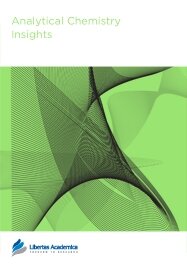

Publication Date: 11 Dec 2007
Journal: Analytical Chemistry Insights

1Department of Occupational Health, Tehran University of Medical Sciences, Iran. 2Department of Epidemiology and Biostatistics, Tehran University of Medical Sciences, Iran.
Abstract: Chromium is an important constituent widely used in different industrial processes for production of various synthetic materials. For evaluation of workers’ exposure to trace toxic metal of Cr (III), environmental and biological monitoring are essential processes, in which, preparation of samples is one of the most time-consuming and error-prone aspects prior to analysis. The use of solid-phase extraction (SPE) has grown and is a fertile technique of sample preparation as it provides better results than those produced by liquid-liquid extraction (LLE). SPE using mini columns filled with XAD-4 resin was optimized regarding to sample pH, ligand concentration, loading flow rate, elution solvent, sample volume, elution volume, amount of resins, and sample matrix interferences. Chromium was retained on solid sorbent and was eluted with 2 M HNO3 followed by simple determination of analytes by using flame atomic absorption spectrometery. Obtained recoveries of metal ion were more than 92%. The optimized procedure was also validated with three different pools of spiked urine samples and showed a good reproducibility over six consecutive days as well as six within-day experiments. Through this study, suitable results were obtained for relative standard deviation, therefore, it is concluded that, this optimized method can be considered to be successful in simplifying sample preparation for trace residue analysis of Cr in different matrices for evaluation of occupational and environmental exposures. To evaluate occupational exposure to chromium, 16 urine samples were taken, prepared, and analyzed based on optimized procedure.
PDF (222.45 KB PDF FORMAT)
RIS citation (ENDNOTE, REFERENCE MANAGER, PROCITE, REFWORKS)
BibTex citation (BIBDESK, LATEX)
XML
PMC HTML

I have published more than thirty research papers in internationally reputed high impact factor journals including Libertas Academica publications, Proteomics Insights and Analytical Chemistry Insights. I have no hesitation in saying that Proteomics Insights is highly efficient for its rapid and high quality review process and keeping the authors informed at each stage of the publication process. I recommend this journal for students, teachers and research workers who wish to publish their work. ...

All authors are surveyed after their articles are published. Authors are asked to rate their experience in a variety of areas, and their responses help us to monitor our performance. Presented here are their responses in some key areas. No 'poor' or 'very poor' responses were received; these are represented in the 'other' category.See Our Results
Copyright © 2013 Libertas Academica Ltd (except open access articles and accompanying metadata and supplementary files.)
FacebookGoogle+Twitter
PinterestTumblrYouTube